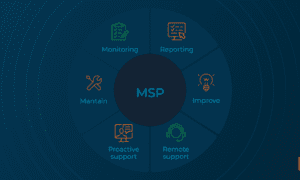Growth is an exciting phase for any business. Teams expand, customers increase, and new opportunities emerge. Yet with this growth also comes complexity. Systems become more interconnected, technology demands rise, and even small technical issues can create bottlenecks that slow down progress. For many organizations, reaching this stage reveals an important truth. Managing IT internally becomes more challenging and less practical as the business scales.
This is where managed IT services come into play. They offer a structured and proactive way for growing businesses to keep operations efficient, secure, and adaptable. Instead of relying on a reactive approach, companies gain access to ongoing support, strategic guidance, and dependable systems that grow with them. The shift not only reduces downtime but also allows business leaders to focus on long term goals rather than day to day tech problems.
In today’s fast moving environment, smooth operations depend heavily on reliable technology. When email goes down, files glitch, or networks slow unexpectedly, the ripple effect can hit productivity, communication, and revenue.
Many leaders find that internal IT teams, especially small ones, struggle to keep up with both maintenance and innovation. Managed IT services provide a solution that strengthens every layer of the organization by bringing structure, expertise, and round the clock coverage.
Proactive Support Instead of Constant Crisis Management
One of the biggest advantages managed service providers offer is proactive monitoring. Instead of waiting for a problem to surface, they track systems continuously and identify potential issues before they become operational headaches. Growing businesses benefit from fewer disruptions and more predictable workflows.
Proactive support often includes system updates, security checks, regular backups, and network monitoring. By handling these tasks in the background, service providers free internal teams from repetitive technical responsibilities. This allows staff to focus on strategic projects linked to revenue and growth.
For example, instead of pausing operations to troubleshoot a failing server, the provider would detect performance dips early, take preventive action, and restore stability. The business avoids downtime that might have otherwise derailed an entire workday. Over time, this creates a culture of consistency and reliability that employees appreciate and depend on.
Enhanced Cybersecurity for a More Vulnerable Digital Landscape
As companies grow, so does their exposure to cyber threats. More devices, more software, and more users create a wider attack surface. Cybercriminals increasingly target small and mid sized businesses because they often have weaker defenses compared to large enterprises.
Managed IT services strengthen cybersecurity by implementing layered protection strategies. These can include advanced firewalls, endpoint protection, threat detection tools, encrypted data storage, and detailed access controls. Providers also perform regular security assessments to identify vulnerabilities and apply patches or updates promptly.
Employee training is another key component. Human error remains one of the biggest risks in cybersecurity. Through ongoing education, businesses reduce the likelihood of phishing attacks, password mishandling, and unsafe browsing practices.
In addition to prevention, managed service providers offer fast incident response. If a breach or security issue occurs, having experts in place minimizes damage and downtime. This is critical because swift action can mean the difference between minor disruption and major financial loss.
Scalable Solutions That Flex With Business Demands
Growing businesses face fluctuating technology needs. A company may add new employees in rapid waves, open additional offices, adopt new software tools, or require more storage as operations expand. Internal IT departments may not have the bandwidth or expertise to adjust quickly.
Managed IT services excel in scalability. Providers can easily increase or decrease resources based on the client’s needs. This flexibility supports growth without forcing the business to overinvest in equipment or staffing. Instead of buying expensive hardware or hiring multiple technicians, companies gain access to a full team of experts who adapt solutions as the business evolves.
This scalable approach ensures that businesses stay ahead of operational demands. Whether a company is entering a new market or implementing automation tools, managed IT services help maintain performance and stability throughout the transition.
In this context, many businesses turn to managed it services New Jersey to ensure they have the right level of support as they expand and modernize their operations.
Cost Efficiency Without Sacrificing Quality
One misconception among growing businesses is that managed IT services are costly. In reality, they often reduce expenses compared to maintaining a full internal IT team. Dedicated staff require salaries, benefits, training, and equipment. They may also lack specialized knowledge in certain areas, which limits the support they can provide.
Managed service providers offer predictable monthly pricing, making budgeting simpler. Costs align with service levels, so companies pay only for what they need. This eliminates unexpected expenses associated with emergency repairs or outdated equipment. Many providers also help businesses optimize software licensing, cloud subscriptions, and hardware investments.
By spreading expertise across many clients, service providers deliver enterprise level support at a fraction of the cost of building a comparable internal team. The result is high quality service with a structure that supports long term financial stability.
Centralized Management of Complex Systems
As organizations grow, their technology ecosystems often become more complicated. Multiple applications, servers, networks, and devices need to work together without interruption. Without proper oversight, this complexity leads to data silos, integration issues, and inconsistent performance.
Managed IT services simplify complexity by centralizing management. Providers gain a full view of the company’s systems and handle maintenance, updates, and troubleshooting from a unified approach. This reduces confusion and improves transparency.
Centralized management also helps with compliance, an area that becomes increasingly important as companies handle more data. Providers ensure that industry regulations are followed and that sensitive information is securely protected.
With a single team overseeing all systems, businesses gain clearer communication, faster problem resolution, and more consistent performance across departments.
Improved Productivity Through Reliable Technology
Employees rely heavily on dependable technology to do their jobs effectively. Slow applications, unstable Wi Fi, and outdated equipment create frustration and disrupt workflow. Over time, these issues contribute to lost productivity that can impact revenue.
Managed IT services enhance productivity by ensuring that systems run smoothly. Teams can work confidently without worrying about sudden crashes or delays. When issues do arise, support is fast and accessible, often resolving problems within minutes.
IT providers also help businesses adopt new tools that improve collaboration, automate manual tasks, and streamline communication. This can include cloud based platforms, project management systems, or modern communication tools. With expert guidance, businesses can implement these solutions without the complications that often accompany new technology.
Guidance for Long Term Technology Strategy
As companies scale, their technology strategy becomes increasingly important. Decisions about software, infrastructure, and security have long term consequences. Choosing the wrong tools or failing to plan for the future can slow growth and drive up costs.
Managed service providers act as strategic partners, not just technicians. They offer guidance on the best solutions to support the company’s goals. Whether a business is preparing for expansion, shifting to remote work, or implementing automation, providers help create a roadmap that aligns with the company’s vision.
This long term planning ensures that technology investments deliver value and remain relevant as the business evolves. It also helps leaders make informed decisions that support innovation and sustainable growth.
Conclusion
Smooth operations are essential for every growing business, and technology plays a central role in maintaining that momentum. Managed IT services provide the expertise, scalability, and proactive support needed to keep systems running efficiently while protecting the organization from risks. Instead of reacting to problems as they arise, companies gain a stable and strategic foundation that supports long term success.
By partnering with a trusted managed service provider, businesses reduce downtime, strengthen security, and gain access to a team of specialists who guide their technology decisions. This allows leaders to stay focused on innovation, customer satisfaction, and expansion while knowing that every technical detail is handled with care.
Managed IT services are more than a support system. They are an integral part of a company’s growth strategy.



































